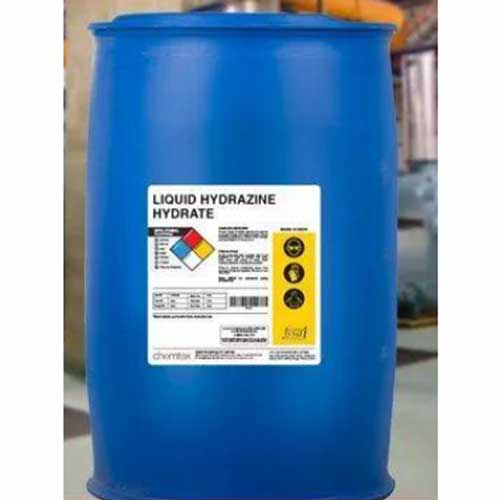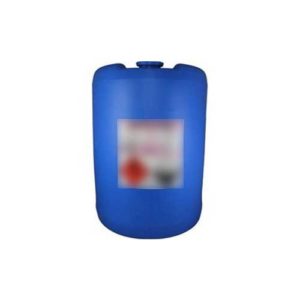HYDRAZINE HYDRATE (N2H4·H2O)
ABOUT:
Hydrazine hydrate is typically manufactured by the Raschig process, which involves the reaction of sodium hypochlorite with ammonia in the presence of a reducing agent. The process is typically carried out in a reactor vessel with stirring and cooling.
- Chlorine gas is bubbled through a solution of sodium hydroxide to produce sodium hypochlorite.
- Ammonia gas is bubbled into the reactor vessel containing the sodium hypochlorite solution, and the mixture is stirred.
- A reducing agent, such as hydrogen peroxide, is added to the mixture to help drive the reaction and prevent the formation of unwanted byproducts.
- The mixture is allowed to react for a period of time, during which hydrazine hydrate is formed.
- The reaction mixture is then filtered to remove any solids, and the hydrazine hydrate solution is purified using distillation or other methods.
PHYSICAL PROPERTIES:
Appearance: colorless liquid
Odor: odor similar to ammonia
Melting point: 1.4°C (34.52°F)
Boiling point: 113.5°C (236.3°F)
Density: 1.03 g/cm³ at 20°C (68°F)
Vapor pressure: 1 mmHg at 20°C (68°F)
Molecular weight: 50.06 g/mol (anhydrous N2H4)
CHEMICAL PROPERTIES:
- Hydrazine hydrate is highly soluble in water, alcohol, and ether. It is also soluble in most organic solvents, such as benzene and chloroform.
- Hydrazine hydrate is a weak base, with a pKa of 8.0. It can react with acids to form hydrazinium salts.
- Hydrazine hydrate is a strong reducing agent, meaning it can donate electrons to other molecules. It is commonly used as a reducing agent in various chemical reactions.
- Hydrazine hydrate is a highly reactive chemical, which can react violently with certain other chemicals, such as acids, oxidizers, and metal powders.
- Hydrazine hydrate is relatively unstable and can decompose rapidly, especially under certain conditions such as high temperature, exposure to light, or contact with certain catalysts.
- Hydrazine hydrate is highly toxic and can be harmful if ingested, inhaled, or absorbed through the skin. It can cause severe burns, lung damage, and even death. Proper safety precautions must be taken when handling this chemical.
APPLICATIONS:
AGROCHEMICALS INDUSTRY:
- Hydrazine hydrate is used as a key intermediate in the synthesis of several pesticides such as pyrazole, triazole, and pyridazine.
- Hydrazine hydrate is used as a plant growth regulator in agriculture. It promotes growth and enhances the yield of crops such as rice, wheat, and cotton.
- Hydrazine hydrate is used as herbicide and fungicide.
- Hydrazine hydrate is a good source of nitrogen for plants. It can be used as a fertilizer to provide nitrogen to crops.
PHARMACEUTICALS:
- Hydrazine hydrate is used as a reducing agent in the synthesis of various pharmaceutical compounds. It is used to reduce carbonyl groups to hydroxyl groups, to cleave certain functional groups, and to reduce nitro compounds to amino compounds.
- Hydrazine hydrate is used to stabilize drugs and pharmaceutical intermediates. It can prevent oxidation and degradation of the active ingredient.
- Hydrazine hydrate is a precursor for the synthesis of various pharmaceutical intermediates. These intermediates are used in the production of drugs such as anticancer agents, antibiotics, and antiviral drugs.
POLYMERS:
-
- Hydrazine hydrate is used as a chain extender in the production of polyurethane polymers. It reacts with isocyanates to form urea linkages, which increases the molecular weight of the polymer and improves its mechanical properties.
- Hydrazine hydrate is used as a cross-linking agent in the production of epoxy resins. It reacts with epoxides to form cross-linked polymers, which improves their thermal and mechanical properties.
BLOWING AGENT:
- In the production of polyurethane foam, hydrazine hydrate is used as a blowing agent. The reaction of polyols and isocyanates generates carbon dioxide gas, which is amplified by the presence of hydrazine hydrate as a co-blowing agent.
- Hydrazine hydrate is a blowing agent used in the manufacture of polystyrene foam. Melted polystyrene is extruded into a mould, where hydrazine hydrate is injected.
- Hydrazine hydrate is used as a blowing agent in the production of phenolic foam. Phenolic resins are mixed with a catalyst and hydrazine hydrate, which generates gas that expands the mixture.
USED IN WATER TREATMENT:
- In water treatment, hydrazine hydrate is commonly used as an oxygen scavenger. It combines with dissolved oxygen in water to form nitrogen and water, removing oxygen from the solution.
- Hydrazine hydrate is also used in water treatment as a corrosion inhibitor. It forms a protective film on metal surfaces, which aids in corrosion prevention.
- In boiler water treatment, hydrazine hydrate is commonly used to remove dissolved oxygen from the feedwater. This aids in the prevention of corrosion and the extension of the boiler’s life. It’s also used as an antioxidant in boiler water treatment to keep boiler feedwater and steam condensate from degrading.
- Hydrazine hydrate is used as an oxygen scavenger in RO water treatment systems. It helps to remove dissolved oxygen from the RO feedwater, which can cause fouling and membrane damage.
ROCKET FUEL PROPELLANT:
- Hydrazine hydrate is frequently used as a monopropellant in rocketry, which means it serves as both the fuel and the oxidizer for the rocket engine. This simplifies the engine’s design and reduces the rocket’s overall weight.
- Hydrazine hydrate is also used in bipropellant rocket systems, usually in conjunction with an oxidizer such as nitrogen tetroxide.
- The high energy content, low molecular weight, and low freezing point of hydrazine hydrate make it an excellent rocket fuel. It also has a high vapour pressure, making it easy to store and use as a liquid fuel.
SAFETY MEASURES:
- Wear appropriate personal protective equipment (PPE), such as gloves, goggles, and a lab coat, when handling hydrazine hydrate. A self-contained breathing apparatus may also be necessary if the concentration of hydrazine hydrate vapors is high.
- Store hydrazine hydrate in a cool, dry, and well-ventilated area away from oxidizing agents, acids, and other incompatible substances. Keep it in tightly sealed containers and label them properly.
- When handling hydrazine hydrate, use tools made of non-sparking materials, and avoid all direct contact with the skin or clothing. Do not mix it with any other substances, and always add it slowly to other chemicals to avoid any exothermic reactions.
- In case of a spill or leak, evacuate the area immediately and ventilate it. Wear appropriate PPE, such as gloves and goggles, and use an absorbent material, such as vermiculite or sand, to contain and clean up the spill. Dispose of the contaminated material in accordance with local regulations.
- Dispose of hydrazine hydrate in accordance with local, state, and federal regulations. It is recommended to have a professional waste disposal company handle the disposal of hydrazine hydrate.
- Ensure that all personnel who work with hydrazine hydrate are properly trained in its safe handling, storage, and disposal. Regular training and refresher courses should be provided to keep employees up to date with the latest safety procedures and protocols.
- Establish emergency procedures, such as first aid measures and evacuation plans, in case of accidental exposure to hydrazine hydrate. Make sure that all employees are aware of these procedures and know how to respond in an emergency.
PACKAGING:
- Hydrazine hydrate is typically packed and transported in high-density polyethylene (HDPE) or polypropylene (PP) containers that are resistant to the chemical’s corrosive and reactive nature. And it comes in 200kgs barrel.





Reviews
There are no reviews yet.